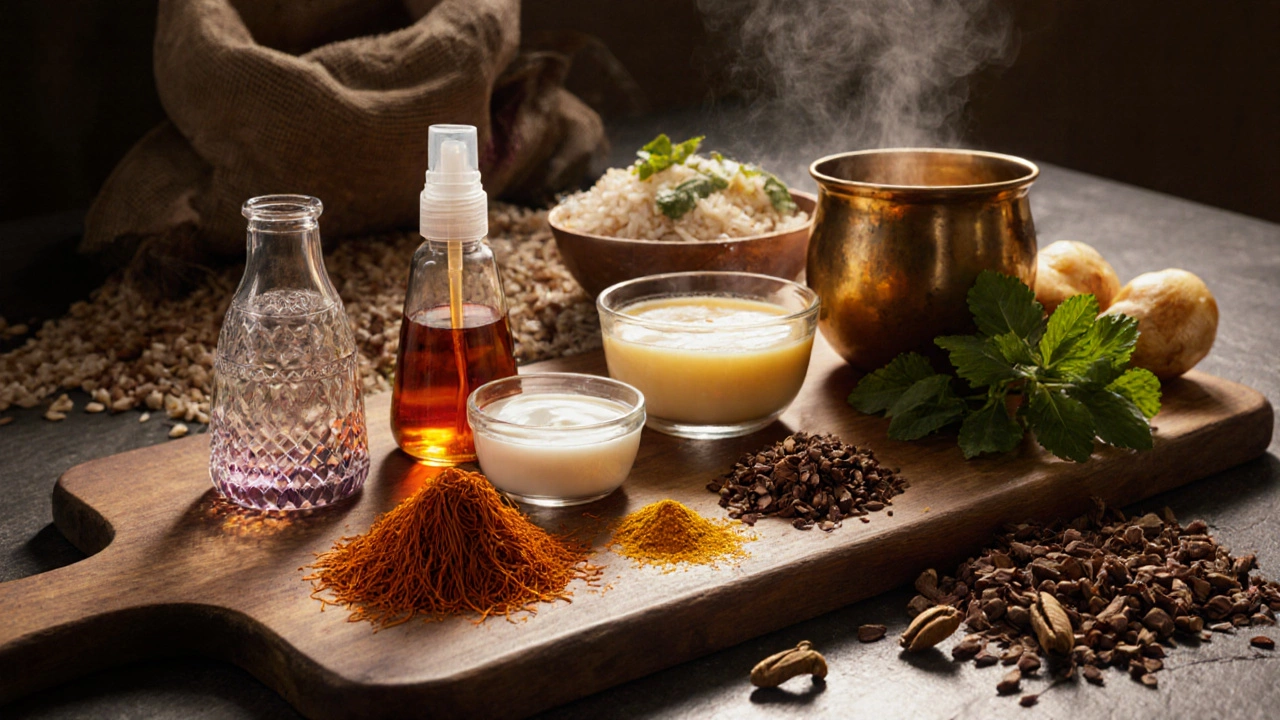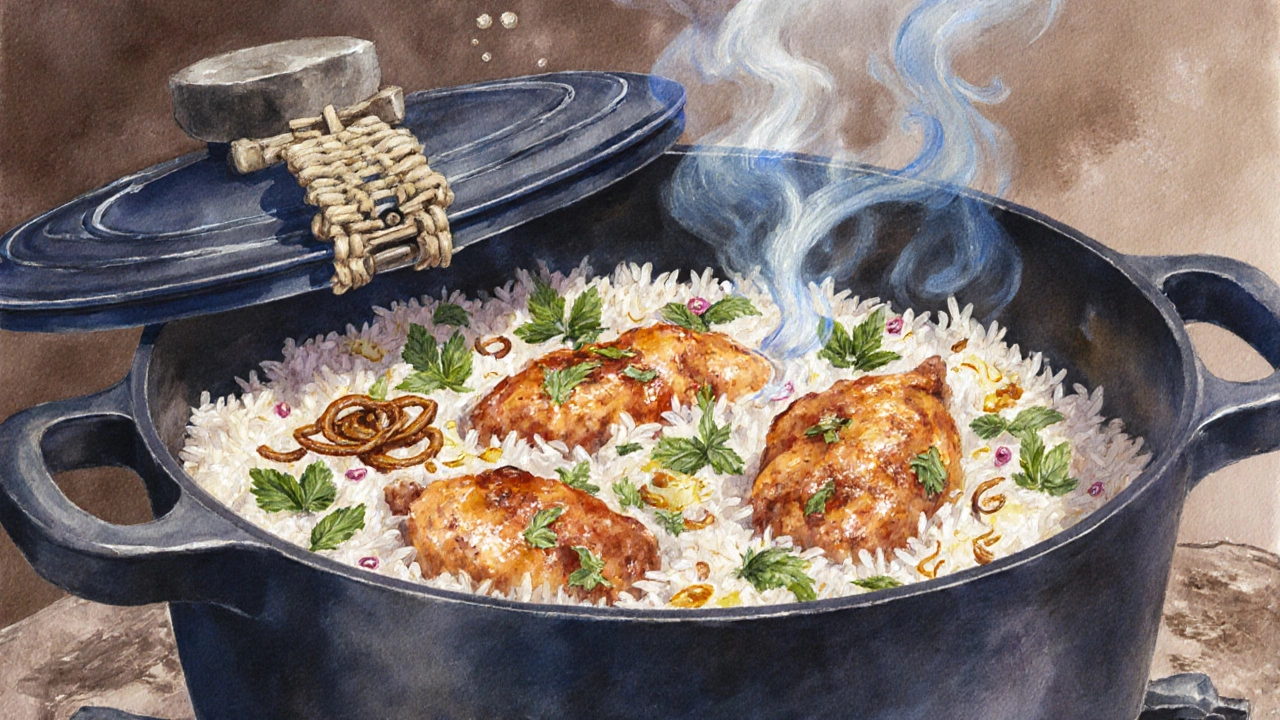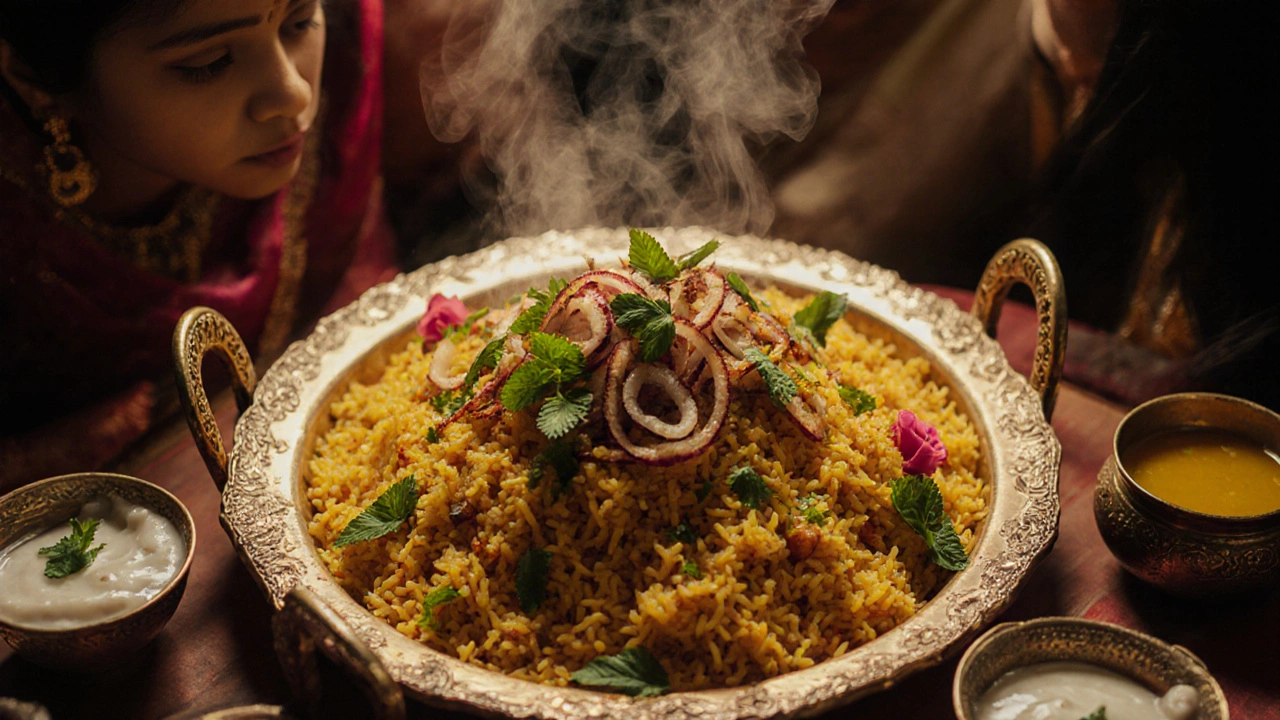Secret Ingredients That Make Biryani Irresistible

Biryani Secret Ingredient Checker
Use this tool to check if you have the essential secret ingredients for making irresistible biryani. Select the ingredients you have in your pantry:
Saffron
Golden hue and aroma
Kewra Water
Sweet floral perfume
Rose Water
Floral essence
Fried Onions
Caramelized crunch
Ghee
Clarified butter
Yogurt
Tenderizes meat
Ingredients You Have
- None
Missing Ingredients
- None
Recommendation
Select ingredients to see your pantry status and recommendations.
- Premium basmati rice (aged 1–2 years for best fluffiness)
- Saffron or a turmeric + kewra/rose water combo
- Full-fat yogurt (plain, no additives)
- Ghee (or clarified butter)
- Fried onions (birista) stored in oil
- Kewra water and rose water (small bottles last months)
- Fresh mint and coriander leaves
- Whole spices: bay leaf, cinnamon stick, cloves, green cardamom
- Meat or vegetables of your choice, pre-marinated
Cross each item off before you start. Missing even one can make the difference between “good” and “memorable.”
Ever wondered why some biryanis taste like a party in your mouth while others fall flat? The answer usually hides in a handful of less‑talked‑about ingredients that turn a good pot of rice into a legendary feast. Below we pull back the curtain on those hidden gems, explain how they work, and show you how to use them without breaking the bank.
Key Takeaways
- Premium saffron isn’t the only way to get that signature golden hue and fragrant lift.
- Ingredients like kewra water, rose water, and fried onions add depth that spices alone can’t achieve.
- Balancing dairy (yogurt, ghee, milk) with acid and aromatics is crucial for tender meat and fluffy rice.
- Layering technique and proper “dum” sealing lock in flavor and moisture.
- A quick checklist at the end helps you audit your pantry before you start cooking.
The Core Building Blocks of Biryani Flavor
Before we dive into the secrets, let’s recap the basics. A classic biryani combines three pillars: high‑quality basmati rice, a well‑spiced protein or vegetables, and a cooking method that steams everything together. On top of that, the real magic comes from a handful of specialty ingredients that many home cooks overlook.
Below you’ll meet the stars of the show. The first mention of each is wrapped in Schema.org microdata so search engines can recognize them as distinct entities.
Saffron is a dried stigma of the Crocus sativus flower, prized for its deep orange‑gold color and distinctive earthy‑floral aroma. A pinch can transform plain rice into a show‑stopper, but it’s pricey and easy to overuse.
Kewra water is a fragrant distillate made from the male flowers of the screwpine tree, delivering a sweet, slightly citrusy perfume that pairs beautifully with meat‑based biryanis.
Rose water is a floral essence extracted from Rosa damascena petals. A few drops lend a subtle perfume that softens the heat of chilies.
Fried onions (birista) are thinly sliced onions cooked until deep brown and crisp, then stored in oil. They add caramelized sweetness and a crunchy texture that’s impossible to replicate with fresh onions.
Ghee is clarified butter with a high smoke point and nutty flavor, ideal for sautéing spices and sealing the pot during dum cooking.
Yogurt provides acidity that tenderises meat while contributing a creamy mouthfeel to the rice.
Mint leaves bring a refreshing burst that cuts through richness and balances aromatic intensity.
The “Golden” Secret: Saffron and Its Alternatives
Traditional biryanis use saffron for two reasons: color and aroma. The pigment crocin gives a warm gold that signals luxury, while picrocrocin delivers that characteristic earthy scent.
Because saffron can cost £10‑£15 per gram, many cooks opt for cheaper substitutes that still provide a visual cue. A blend of turmeric (for color) plus a few drops of kewra water or rose water (for fragrance) can mimic saffron’s effect at a fraction of the price.
Here’s a quick rule of thumb: use 0.1g of saffron (≈ a pinch) per kilogram of rice, or replace it with ½tsp turmeric plus 2ml of kewra water. This ratio keeps the rice from turning an unappealing orange while preserving a nuanced aroma.

Aromatic Boosters: Kewra, Rose Water, and Cardamom
Kewra water and rose water are both used in regional styles-Kewra in Hyderabadi and Kolkata biryanis, rose water in Lucknow’s Awadhi version. They’re added during the final layering, just before sealing the pot.
A typical dosage is 2-3ml of kewra or rose water for a 2‑kg batch. Too much can make the biryani taste perfumy, so start low and taste after each addition.
Green cardamom pods, another aromatic powerhouse, are often bruised and tossed into the rice. They release a citrus‑spicy oil that complements the sweet notes from fried onions.
The Magic of Dairy: Yogurt, Ghee, and Milk
Yogurt’s tang is essential for breaking down protein fibers. For a 1‑kg chicken biryani, blend 150‑200ml of full‑fat yogurt with ginger‑garlic paste, salt, and a pinch of red chili powder. Marinate the meat for at least 2hours; overnight yields the most tender result.
Ghee serves a dual purpose: it fries whole spices (bay leaf, cinnamon, cloves) without burning, and it forms a thin glossy layer on top of the rice when the pot is sealed. This layer locks in steam, ensuring the rice cooks evenly during the dum phase.
Some chefs splash a splash of warm milk (≈ 50ml) into the final rice layer. The milk’s lactose adds a subtle sweetness that balances the heat from chilies.
Layering and Dum Technique: Why It Matters
The “dum” method is the heart‑beat of biryani. After partially cooking the rice and meat separately, you layer them in a heavy‑bottomed pot (often a Dutch oven or traditional handi). Each layer should be alternated: meat, rice, herbs, fried onions, a drizzle of ghee, and a few drops of your chosen aromatic water.
Seal the pot tightly with a dough‑made lid or heavy foil, then place a weight (like a clean stone or pan) on top. Cook on low heat (≈120°C) for 20‑30minutes. This gentle steam infusion allows flavors to meld while the rice absorbs the aromatics without becoming mushy.

Secret Veggies and Herbs: Mint, Coriander, and Fried Onions
Fresh mint and coriander leaves are sprinkled between layers. Their bright, herbaceous notes lift the richness of ghee and meat. A handful (≈30g) of each per kilogram of rice is enough.
Fried onions (birista) are the unsung heroes. Prepare them in advance: slice onions thin, fry in ghee at medium heat until dark brown, then cool and store in the same oil. They add a deep caramel flavor that fresh onions can’t match.
Don’t forget the green chili slit lengthwise-its oil drips into the rice during the final steam, giving a gentle heat that rises in the background rather than overwhelming the palate.
Mini Checklist: Do You Have These Ingredients?
- Premium basmati rice (aged 1‑2years for best fluffiness)
- Saffron or a turmeric + kewra/rose water combo
- Full‑fat yogurt (plain, no additives)
- Ghee (or clarified butter)
- Fried onions (birista) stored in oil
- Kewra water and rose water (small bottles last months)
- Fresh mint and coriander leaves
- Whole spices: bay leaf, cinnamon stick, cloves, green cardamom
- Meat or vegetables of your choice, pre‑marinated
Cross each item off before you start. Missing even one can make the difference between “good” and “memorable.”
Frequently Asked Questions
Frequently Asked Questions
Can I use a smaller amount of saffron and still get the color?
Yes. A pinch (about 0.05g) will colour a 2‑kg batch lightly. For a richer hue, combine the pinch with ½tsp turmeric; the turmeric adds colour without altering saffron’s aroma.
Is kewra water essential, or can I skip it?
Kewra isn’t mandatory, but it adds a distinctive sweet‑savory perfume that many associate with authentic Hyderabad biryani. If you don’t have it, a couple of drops of rose water or a pinch of cardamom can fill the gap.
How long should I marinate the meat in yogurt?
At least 2hours for chicken or lamb pieces, but overnight in the fridge yields the most tender, flavor‑infused result. The acid in yogurt breaks down connective tissue, preventing dryness during the dum phase.
What’s the best pot for the dum technique?
A heavy‑bottomed, tight‑fitting pot such as a Dutch oven, cast‑iron handi, or a stainless steel pot with a lid that seals well. If the lid isn’t airtight, wrap the pot in foil and then seal with a clean kitchen towel before placing the weight on top.
Can I make a vegetarian biryani using these secret ingredients?
Absolutely. Replace meat with paneer, mixed vegetables, or tofu, and keep the same yogurt‑marinade for the veggies. The aromatic boosters (kewra, rose water, fried onions) work just as well with plant‑based proteins.
Armed with these ingredients and techniques, you can turn any ordinary biryani into a festival of flavors that makes guests ask for seconds. Remember, the secret isn’t a single spice-it’s the harmony of several often‑overlooked elements working together.